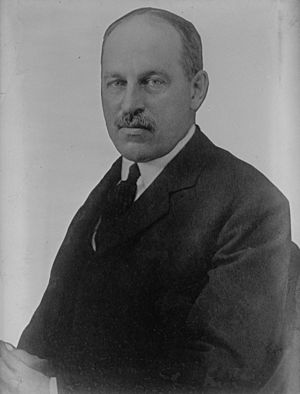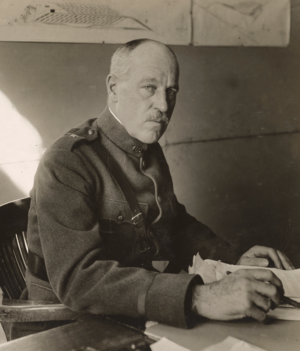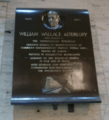William Wallace Atterbury facts for kids
Quick facts for kids
William Wallace Atterbury
|
|
|---|---|

Atterbury circa 1913
|
|
| Member of the Republican National Committee from Pennsylvania |
|
| In office May 12, 1928 – October 10, 1930 |
|
| Preceded by | George Pepper |
| Succeeded by | Jay Cooke |
| Personal details | |
| Born | January 31, 1866 New Albany, Indiana |
| Died | September 20, 1935 (aged 69) Philadelphia, Pennsylvania |
| Political party | Republican |
| Spouses | Matilda Hoffman (m. November 13, 1895 – her death in 1910) Arminia (Rosengarten) MacLeod (m. June 10, 1915 – his death in 1935) |
| Children | Malcolm MacLeod Atterbury (adopted) George Rosengarten MacLeod Atterbury (adopted) William W. Atterbury Jr. |
| Alma mater | Yale University (Ph.B.) |
William Wallace Atterbury (January 31, 1866 – September 20, 1935) was an important American leader. He became a brigadier general in the United States Army during World War I. Before and after the war, he worked for the Pennsylvania Railroad. He started there in 1886 and eventually became its tenth president from 1925 to 1935.
During World War I, Atterbury was in charge of transportation in France. He helped organize trains and supplies for American soldiers. People called him "The Railroad General." After the war, he led a huge project to make the Pennsylvania Railroad's main lines electric. These lines ran between New York City and Washington, D.C.. He also helped create the company's first M1-class steam locomotive.
Atterbury received the U.S. Army's Distinguished Service Medal. He also got awards from France, England, Serbia, and Romania for his military service. Several places were named after him, including Camp Atterbury in Indiana.
Contents
Who Was William Wallace Atterbury?
William Wallace Atterbury was born in New Albany, Indiana, on January 31, 1866. He was the seventh son of John Guest Atterbury. His father was a lawyer who became a Presbyterian minister. William was the youngest of twelve children in his family.
His Education and College Life
Atterbury went to Yale University's Sheffield Scientific School. He earned a Ph.B. degree in 1886. This degree was similar to a bachelor's degree today. While at Yale, he was a member of the Chi Phi Fraternity.
Atterbury's Family Life
On November 13, 1895, Atterbury married Matilda "Minnie" Hoffman in Fort Wayne, Indiana. Sadly, she passed away in 1910.
He married Arminia Clara (Rosengarten) MacLeod on June 10, 1915. She was from Philadelphia, Pennsylvania. Atterbury adopted Arminia's two sons, Malcolm and George. William and Arminia also had their own son, William Wallace Atterbury Jr. The family lived in Radnor, a town near Philadelphia.
William Atterbury's Career Journey
Starting Out in Railroads
In 1886, Atterbury began his career as an apprentice at the Altoona Works. This was a major repair shop for the Pennsylvania Railroad in Altoona. He earned five cents an hour at the start.
He quickly moved up in the company. By 1901, he was the general superintendent of motive power at Altoona Works. This meant he was in charge of the power systems for the trains. In 1903, he became a general manager for the railroad's eastern lines. By 1909, he was a company vice president in charge of transportation. In 1912, he became vice president of operations. In 1916, he also became president of the American Railway Association.
Leading During World War I
On August 6, 1917, Atterbury took a break from the Pennsylvania Railroad. He joined the American Expeditionary Forces (AEF) in France during World War I. He became the AEF's director-general of transportation. On October 5, 1917, he was made a brigadier general in the United States Army.
From 1917 to 1919, Atterbury oversaw the building of port facilities and railways in France. These were used by the U.S. Army to move troops and supplies. Soldiers in France gave him the nickname "General Attaboy." He was also known as "The Railroad General." He left the military on May 31, 1919, and went back to his civilian job.
After the War: Railroad President
In 1920, Atterbury returned to the Pennsylvania Railroad as vice president of operations. On October 1, 1925, he became the tenth president of the company. He held this important job until 1935.
During his time as president, the Pennsylvania Railroad started a huge project. They spent $250 million to make 245 miles (394 km) of their main line electric. This line connected New York City and Washington, D.C.. The project began in 1928 and finished in 1935. It was the largest project ever done by an American railroad at that time. Atterbury also helped create the company's first M1-class steam locomotive. He retired from the railroad in 1935 because of poor health.
Atterbury was also involved in politics in Pennsylvania. He was a delegate for Pennsylvania at the 1920 Republican National Convention. He was also a member of Pennsylvania's Republican State Committee.
His Death and Lasting Impact
William Wallace Atterbury passed away on September 20, 1935, in Radnor, Pennsylvania. He died from a stroke. He is buried at Old Saint David's Churchyard Cemetery in Radnor.
On February 16, 1942, the U.S. War Department announced a new military training camp. It was built near Edinburgh, Indiana, and named Camp Atterbury in his honor. An airfield nearby was also named Atterbury Army Airfield in 1943. Today, this airfield is the Columbus Municipal Airport.
Awards and Recognitions
For his service in World War I, the U.S. Army gave Atterbury the Distinguished Service Medal. He also received high honors from other countries:
- Commander of the Legion of Honor (France)
- Companion of the Most Honorable Order of the Bath (England)
- Commander of the Royal Order of the White Eagle (Serbia)
- Grand Officer of the Order of the Crown (Romania)
Atterbury also received honorary degrees from several universities. Yale University gave him an honorary M.A. in 1911. He received honorary LL.D. degrees from the University of Pennsylvania in 1919, Yale University in 1926, Villanova University in 1927, and Temple University in 1929.
Images for kids
-
Atterbury on the cover of Time Magazine in 1933.




